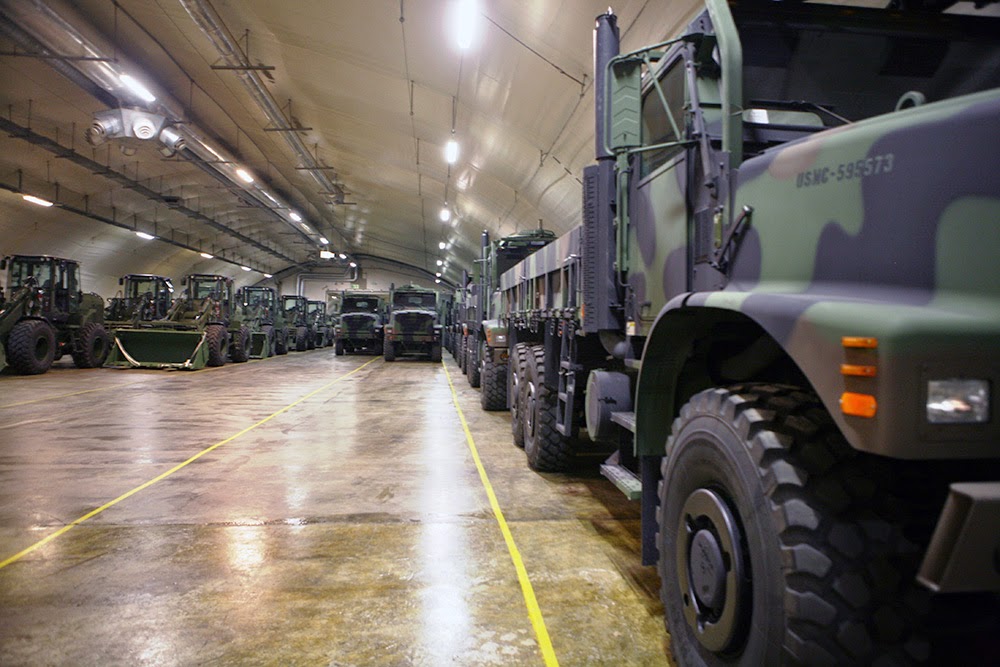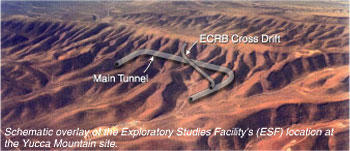 [Image: “Humvees are stored inside the Frigaard Cave in central Norway. The cave is one of six caves that are part of the Marine Corps Prepositioning Program-Norway, which supports the equipping of Marine Expeditionary Brigade consisting of 15,000 Marines and with supplies for up to 30 days.” U.S. Marine Corps photo by Lance Cpl. Marcin Platek].
[Image: “Humvees are stored inside the Frigaard Cave in central Norway. The cave is one of six caves that are part of the Marine Corps Prepositioning Program-Norway, which supports the equipping of Marine Expeditionary Brigade consisting of 15,000 Marines and with supplies for up to 30 days.” U.S. Marine Corps photo by Lance Cpl. Marcin Platek].
Norwegian caves are being stuffed full of U.S. military equipment, including armored Humvees, tanks, and cargo containers full of weaponry, all part of a vast and semi-subterranean supply chain maintained to help wage future wars around the world.
The Marines have “stashed weapons and equipment in the Norwegian countryside since the 1980s,” War is Boring explains, in sites that include artificially enlarged and fortified caves. It’s all about logistics: “With this setup, Marines can fly in and be ready for a fight in no time.”
 [Image: “Rows of front loaders and 7-ton trucks sit, gassed up and ready to roll in one of the many corridors in the Frigard supply cave located on the Vaernes Garrison near Trondheim, Norway. This is one of seven [see previous caption!] caves that make up the Marine Corps Prepositioning Program-Norway facility. All the caves total more than 900,000 sq. ft. of storage space, full of enough gear to outfit 13,000 Marines for up to 30 days.” U.S. Marine Corps photo by Sgt. Matt Lyman].
[Image: “Rows of front loaders and 7-ton trucks sit, gassed up and ready to roll in one of the many corridors in the Frigard supply cave located on the Vaernes Garrison near Trondheim, Norway. This is one of seven [see previous caption!] caves that make up the Marine Corps Prepositioning Program-Norway facility. All the caves total more than 900,000 sq. ft. of storage space, full of enough gear to outfit 13,000 Marines for up to 30 days.” U.S. Marine Corps photo by Sgt. Matt Lyman].
These facilities are commonly described as “supply caves,” and they hold warfighting gear in a state of indefinite readiness, “reserved for any time of crisis or war.”
Marines can simply fly in, unlock their respective caves, and grab the keys to one of hundreds, if not thousands, of combat-ready vehicles, all “gassed up and ready to roll in one of the many corridors” of this subterranean empire on the edges of American influence.
Among many other points of interest, the Marines identify six such supply caves in the caption of one image and seven caves in the caption of another, as if—assuming this is not just a minor clerical error—the Marines themselves don’t even know how many caves they have.
Instead, there’s just Norway, some faraway land of underground voids we’ve stuffed full of combat gear, like emperors stocking our own tombs in advance of some future demise—the actual number of caves be damned, for who will be left counting at the end of the world?
 [Image: “Medium Tactical Vehicle Replacements, High Mobility Multipurpose Wheeled Vehicles and trailers, which belong to Marine Corps Prepositioning Program-Norway are staged in a storage cave at Tromsdal, Norway, Feb. 24, 2014. Marine Corps began storing equipment in several cave sites throughout Norway in the 1980s to counter the Soviets, but the gear is now reserved for any time of crisis or war.” U.S. Marine Corps photo by Lance Cpl. Sullivan Laramie].
[Image: “Medium Tactical Vehicle Replacements, High Mobility Multipurpose Wheeled Vehicles and trailers, which belong to Marine Corps Prepositioning Program-Norway are staged in a storage cave at Tromsdal, Norway, Feb. 24, 2014. Marine Corps began storing equipment in several cave sites throughout Norway in the 1980s to counter the Soviets, but the gear is now reserved for any time of crisis or war.” U.S. Marine Corps photo by Lance Cpl. Sullivan Laramie].
On one level, I’m reminded of Marcus Trimble’s old joke that France has been constructing a back-up version of itself in China. It is a frenzied act of “pre-emptive preservation,” led by the cultural ministers of that sclerotic nation of well-tended chateaux who realized that la belle France could only survive if they built immediately ready copies of themselves elsewhere.
Only, in France’s case, it wasn’t willful self-burial in Norwegian caves, but in the real estate free-for-all of urban China. After all, Trimble suggested, that country’s “construction industry seems perfect for the task of backing up bricks rather than bits—cheap and powered by the brute force of sheer population. Copies of places may be made in a fraction of the time that it took to create them. If, in the event of a catastrophic episode, the part of France in question could be restored and life would go on as it was before.”
 [Image: “China: ample space for a spare copy of France”; image by Marcus Trimble].
[Image: “China: ample space for a spare copy of France”; image by Marcus Trimble].
Militarize this, secret it away in a cave in Scandinavia, and you have something roughly approximately what’s called the Marine Corps Prepositioning Program.
However, I was also reminded of a recent paper by Pierre Belanger and Alexander Scott Arroyo at Harvard’s GSD. There, Belanger and Arroyo describe the U.S. military as a kind of planetary logistics challenge. (A PDF of their paper is available here courtesy of the U.S. Department of Defense).
Specifically, it is the problem of building and often violently maintaining “logistics islands,” as Belanger and Arroyo describe them, that now characterizes much of the U.S. military’s global behavior, an endless quest for finding and protecting “a secure staging ground adjacent to the theater of operations,” in an era when adjacency is increasingly hard to define. As they explain:
While logistical acquisitions are managed by the Defense Logistics Agency (DLA), logistical operations in the field are predominantly coordinated by USTRANSCOM. On average, the command oversees almost 2,000 air missions and 10,000 ground shipments per week, with 25 container ships providing active logistical support. From October 2009 through September 2010 alone, USTRANSCOM flew 37,304 airlift missions carrying over 2 million passengers and 852,141 tons of cargo; aerially refueled 13,504 aircraft with 338,856,200 pounds of fuel on 11,859 distinct sorties; and moved nearly 25 million tons of cargo in coordinated sea-land operations. DLA and USTRANSCOM and their civilian partners are responsible for the largest, most widespread, and most diverse sustained logistics operation in history.
The largest, most widespread, and most diverse sustained logistics operation in history.
The obvious and intended resonance here is that military operations perhaps now most closely resemble complicated UPS deliveries than anything like actual ground combat. However, we can also infer from this that establishing new and ever more convenient logistics islands is vital to U.S. national security.
A literal archipelago of shipping hubs is thus key to the country’s global military activities, and this not only requires sites like Diego Garcia, which Belanger and Arroyo specifically write about, or even the “mobile offshore bases” they also describe, where the pop-up urbanism of Archigram has been inadvertently realized by the U.S. military, but artificially fortified caves near the Arctic Circle where truly daunting amounts of military materiel are now kept on hand, as if held frozen in some imperial freezer, awaiting the day when global tensions truly heat up.
Read a bit more at War is Boring.
(This is more or less irrelevant, but you might also like Kiln, earlier on BLDGBLOG).



 [Image: The Lærdal Tunnel, photo by Patrick Reijnders, via Wikipedia.]
[Image: The Lærdal Tunnel, photo by Patrick Reijnders, via Wikipedia.] [Image: Drawing courtesy
[Image: Drawing courtesy  [Image: Drawing courtesy
[Image: Drawing courtesy 
 [Images: Drawings courtesy
[Images: Drawings courtesy 
 [Images: Drawings courtesy
[Images: Drawings courtesy  [Image: The
[Image: The  [Image: The antenna field at Jim Creek, via
[Image: The antenna field at Jim Creek, via  [Image:
[Image: 
 [Image: “Humvees are stored inside the Frigaard Cave in central Norway. The cave is one of six caves that are part of the Marine Corps Prepositioning Program-Norway, which supports the equipping of Marine Expeditionary Brigade consisting of 15,000 Marines and with supplies for up to 30 days.”
[Image: “Humvees are stored inside the Frigaard Cave in central Norway. The cave is one of six caves that are part of the Marine Corps Prepositioning Program-Norway, which supports the equipping of Marine Expeditionary Brigade consisting of 15,000 Marines and with supplies for up to 30 days.”  [Image: “Rows of front loaders and 7-ton trucks sit, gassed up and ready to roll in one of the many corridors in the Frigard supply cave located on the Vaernes Garrison near Trondheim, Norway. This is one of seven [see previous caption!] caves that make up the Marine Corps Prepositioning Program-Norway facility. All the caves total more than 900,000 sq. ft. of storage space, full of enough gear to outfit 13,000 Marines for up to 30 days.”
[Image: “Rows of front loaders and 7-ton trucks sit, gassed up and ready to roll in one of the many corridors in the Frigard supply cave located on the Vaernes Garrison near Trondheim, Norway. This is one of seven [see previous caption!] caves that make up the Marine Corps Prepositioning Program-Norway facility. All the caves total more than 900,000 sq. ft. of storage space, full of enough gear to outfit 13,000 Marines for up to 30 days.”  [Image: “Medium Tactical Vehicle Replacements, High Mobility Multipurpose Wheeled Vehicles and trailers, which belong to Marine Corps Prepositioning Program-Norway are staged in a storage cave at Tromsdal, Norway, Feb. 24, 2014. Marine Corps began storing equipment in several cave sites throughout Norway in the 1980s to counter the Soviets, but the gear is now reserved for any time of crisis or war.”
[Image: “Medium Tactical Vehicle Replacements, High Mobility Multipurpose Wheeled Vehicles and trailers, which belong to Marine Corps Prepositioning Program-Norway are staged in a storage cave at Tromsdal, Norway, Feb. 24, 2014. Marine Corps began storing equipment in several cave sites throughout Norway in the 1980s to counter the Soviets, but the gear is now reserved for any time of crisis or war.”  [Image: “China: ample space for a spare copy of France”; image by
[Image: “China: ample space for a spare copy of France”; image by 
 [Image: Via
[Image: Via 

